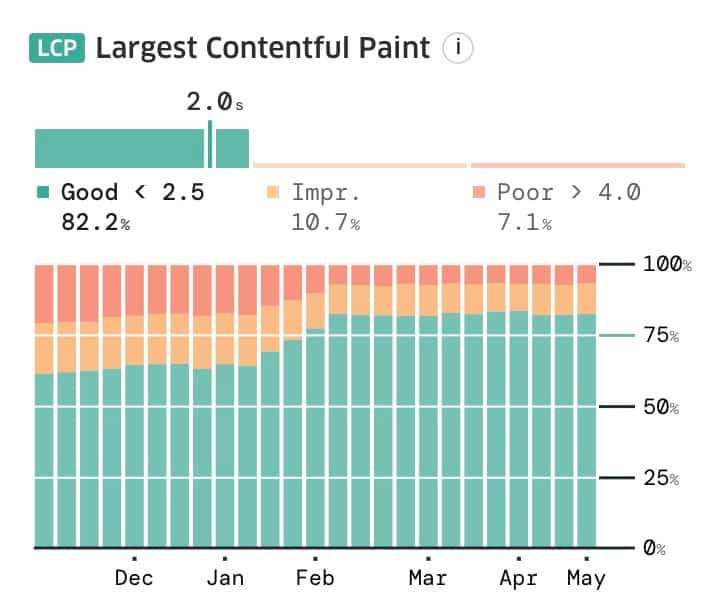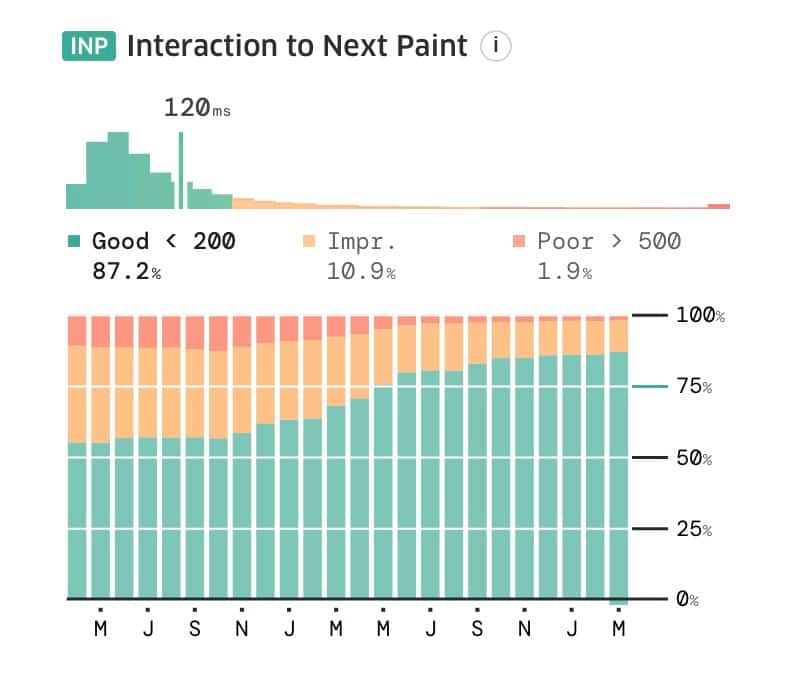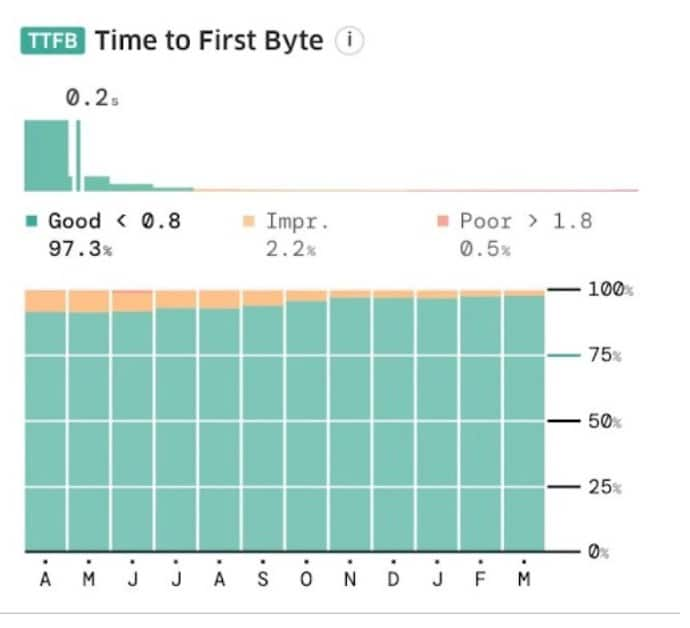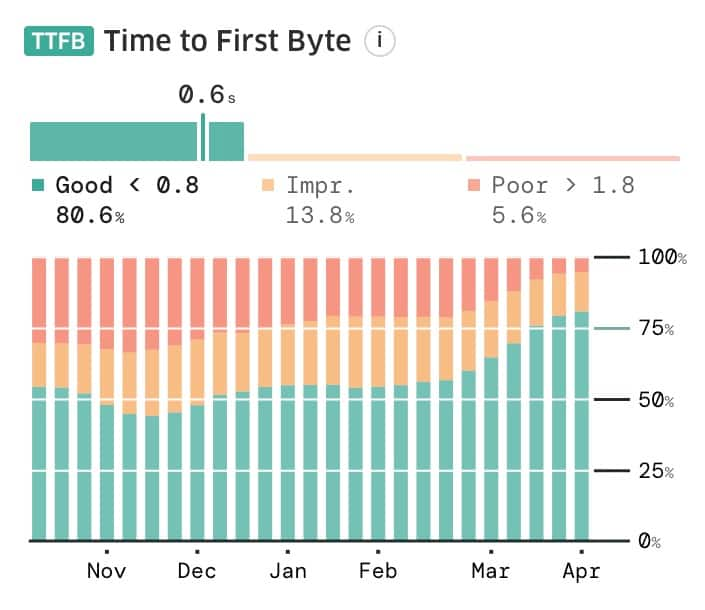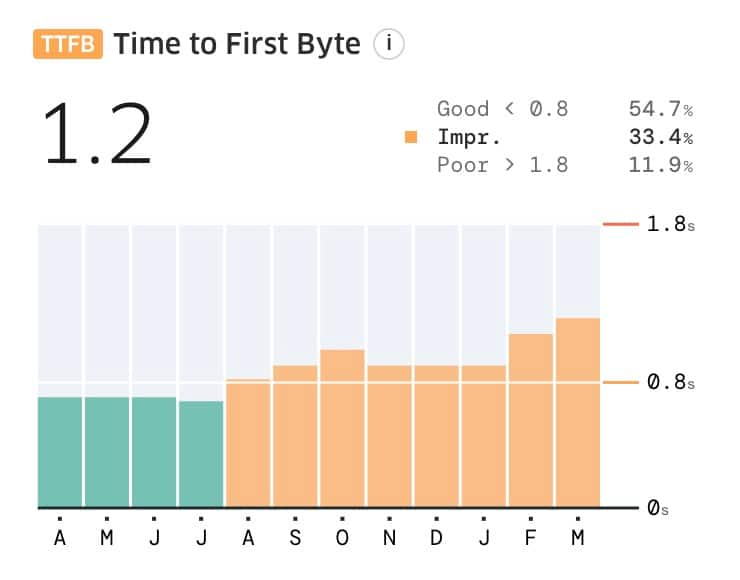Real Performance Improvements 2025
Contents
Introduction
Customers and end users demand instant interactivity now more than ever. Performance remains key to your success, with companies such as Google establishing performance as a key ranking factor in search results. Akamai has invested heavily in site performance. Using our improvements and new features, you can achieve optimal app performance for real-world customers.
In this blog post, we'll demonstrate the positive impact that our improvements have made to our customers’ Core Web Vitals (CWV) metrics. As an SEO ranking signal, especially in 2025, CWV is the de facto standard for looking at real-world performance. We use CWV because it focuses on real users using modern applications — regardless of the connection, location, browser, or device that they’re using.
Next, we’ll show you how these optimizations can be used to improve your application performance; this includes both optimizations that we introduced as well as the features and controls that you can now add to your Akamai configuration to help accelerate your sites and apps.
Let’s jump in.
Real results
The performance improvements that we introduced in the past year can have a measurable impact on real users. Google confirmed this via the Chrome User Experience Report (CrUX). CrUX is a publicly available, Google-provided dataset that offers insights into how real-world users experience websites in terms of performance and loading times.
The data is collected from actual users who have opted in, allowing Google to track and aggregate metrics that reflect fundamental user interactions rather than simulated or lab-based tests.
With Akamai’s new features, we have seen better results in user-centric key performance indicators (KPIs) such as Largest Contentful Paint and Interaction to Next Paint, as well as the more technical but still popular time to first byte. Let’s look at a few examples of websites that saw a positive evolution of those Web Vitals.
NOTE: The following figures are screenshots from the excellent treo.sh tool, which allows you to visualize historical CrUX data for all websites in the dataset.
Largest Contentful Paint
A customer from the hospitality industry implemented 103 Early Hints in January 2025 and immediately noticed a drastic improvement in their Largest Contentful Paint (LCP; Figure 1).
The green portion of the graph at the top shows the percentage of requests for which the LCP was lower than 2.5 seconds. It also shows that 20% more users have a “good" (green) user experience (the LCP was lower than 2.5 seconds) since February compared with the three months prior.
The site was often clocked in “needs improvement” territory (orange)— and was potentially being penalized in Google search results — but is now firmly in the green, which is a strong signal of improved user satisfaction.
Interaction to Next Paint
A security-focused bank realized some impressive Interaction to Next Paint (INP) improvements (Figure 2). They not only made their own implementation improvements, but also benefited from multiple Akamai Bot Manager JavaScript optimizations that were released in the past few months. The bank saw its INP continuously improve from approximately 55% to more than 87% of users having a “good" experience (INP < 200 milliseconds).
Time to first byte
Although not a CWV by itself, time to first byte (TTFB) is still an important metric to track, as it often correlates well with LCP.
An already fast ecommerce website has become even faster over the last eight months as the platform has been improved (more on that in the “What did we improve?” section). Figure 3 shows a continuous increase, in line with the Akamai platform releases, in the percentage of users with a good TTFB experience on that website.
Another customer, in the travel industry, had historically suffered substandard TTFB numbers and was not using Akamai’s available performance optimizations. After implementing some recommended best practices from Akamai’s performance team, that customer saw their TTFB improve from 3 seconds to just 0.6 seconds in a little more than a month (Figure 4).
Impact on a fast website
It's not only slow websites that have gotten faster; even the fastest websites have gotten faster with Akamai. The ecommerce site shown in Figure 5, with millions of visits per month, recently crossed the magical barrier of 500 milliseconds LCP at the P75, has a stunning 50 milliseconds for INP, and a perfect score of 0.00 for Cumulative Layout Shift (CLS).
By using Akamai’s platform, you can build mature and highly scalable sites that benefit from improved uptime with best-in-class performance: no trade-offs, no compromises; just excellence.
What about other CDNs?
At this point in the post, you might have expected a comparison of how we perform relative to other content delivery networks (CDNs). However, especially in 2025, we feel it is difficult to make this type of comparison in good conscience.
One major reason is that real-user CWV metrics depend not only on the speed of the CDN, but also on the programming of a site’s front end and back end, and their specific CDN configurations — all of which can be wildly different among sites. And, of course, you can build both fast and slow websites on any platform.
The alternative would be to use lower-level metrics, such as TTFB. Ostensibly, this is a metric that should be easily comparable among CDNs: You simply download a single object on each CDN, measure the connection setup and request times … and voilà!
However, although it is indeed easy to collect these results, it’s also increasingly meaningless in today’s world of HTTP/3 (and HTTP/2) and their multi-object connections. The efficient (re-)use of these connections through advanced features (such as stream prioritization and bandwidth sharing) matters much more for end-user experience (and metrics like LCP) than the initial setup of that connection.
Additionally, many other techniques change how TTFB is measured in practice, including: 103 Early Hints, Early Data (0-RTT), DNS HTTPS records, the Speculation Rules API, etc. (as we’ll discuss in the “What did we improve?” section).
As a result, measuring TTFB for two single objects on two CDNs — one with and one without even one of these features enabled — can already lead to radically different results that say nothing about what the CDN is actually capable of (as seen in Figures 1-5).
Real-world example
To prove our point, here's an example of a customer that put too much faith in a benchmark that predicted they would see a drastic reduction in their TTFB if they moved away from Akamai (Figure 6). They switched to a different solution in early August 2024 and, unfortunately, their public CrUX data deteriorated instantly.
We focus on CWV data from Akamai customers to show how we impacted real users instead of relying on legacy benchmarking techniques. Don’t be starstruck by big promises; instead, look up the CWVs of some of the biggest sites in the world. It’s highly likely that they’re running on Akamai and have stellar performance.
What did we improve?
Now that you’ve seen the impressive results that you can expect from the improvements we’ve made over the last 12 months, it’s time to discuss in more detail what those enhancements entail. We made enhancements within the following areas:
- Platform
- Akamai Image & Video Manager
- Security solutions
- Real-user monitoring and observability
Platform
At the heart of Akamai is our highly distributed platform that continues to bring more workloads closer to end users. This widespread platform allows us to implement improvements at an unprecedented scale.
The latest enhancements aimed at delivering your content as fast as possible (to real users) include:
- 103 Early Hints
- Early Data (0-RTT)
- TLS 1.3 to the origin
- Speculation Rules API
- DNS optimizations
- Anti-amplification limit
103 Early Hints
For noncacheable resources and cache misses, Akamai edge servers need to contact the origin server. This leaves the connection between the client’s browser and our edge servers idle until the response arrives.
With Early Hints, browsers can use that waiting time to preload the resources that you specify — such as top CSS style sheets, web fonts, logos, or critical JavaScript — as well as preconnect to third-party domains or subdomains. Akamai gives you full edge control over these hints to help you significantly accelerate the rendering experience (LCP).
Early Data (0-RTT)
Early Data is a powerful new feature for both HTTP/2 over Transmission Control Protocol (TCP) and HTTP/3 over QUIC. It allows browsers to save a full network round-trip time (RTT) on most connections to the Akamai edge.
It also works nicely together with other options, such as Early Hints, to get data to your users’ browsers as soon as possible. Akamai allows for fine-grained configuration of the inherent security-performance trade-off of this powerful feature.
TLS 1.3 to the origin
Although we use persistent connections to their maximum potential, sometimes Akamai does need to establish a new TCP connection from our edge to your origin. We added support for TLS 1.3, avoiding the additional RTT needed with TLS 1.2. To take advantage of these latency benefits, make sure to configure your origins correctly.
Speculation Rules API
You can leverage the new Speculation Rules API to speed up multi-page applications by prefetching or prerendering future navigations. This API promises a nearly instant load when prerendering pages that your users might want to access next.
Akamai has various options to deliver Speculation Rules to your end users so you can significantly impact important KPIs such as LCP and CLS.
DNS optimizations
Our DNS team has rolled out the first phases of our next-generation anycast DNS architecture. The program, nicknamed Megacloud, is in progress with 8 of our 22 independent clusters having been converted already.
Megacloud announces each of our anycast networks from more locations. The transition is complex and deliberate to ensure that there are no attack resiliency compromises. The result is faster anycast DNS lookups across all percentiles and regions.
Anti-amplification limit
Normally, QUIC's handshake only takes 1 RTT on the network to complete. However, because Akamai adheres strictly to certain industry security requirements (reflecting the recommendations of RFC 9000), many QUIC (and thus HTTP/3) connections in practice required two RTTs instead.
To solve this problem, we have increased the QUIC anti-amplification limit from three (according to RFC) to seven and now take full advantage of HTTP/3’s performance with only a single RTT to establish the connection.
Image & Video Manager
Sharp-looking images are an essential part of the modern web. For a good LCP, images should load quickly, and two new features of Image & Video Manager will help you achieve this.
SharpYUV Chroma Subsampling: AVIF and HEIF, two modern image formats that we deliver, now use the SharpYUV version of Chroma Subsampling, offering better color representation and compression efficiency.
Cache+: This new add-on allows you to use Akamai Cloud Wrapper for caching Image & Video Manager derivatives. It provides a dedicated cache space within Cloud Wrapper, giving you greater control over eviction policies and cache retention. This is great for performance as it reduces unnecessary reprocessing and ensures that images remain in the cache longer, reducing long-tail misses.
Security solutions
Most of our customers don't want to compromise on security. But that doesn't mean they don’t care about performance.
Over the last 12 months, we have optimized both the edge- and client-side logic of our security solutions (such as Akamai Bot Manager and Akamai Content Protector). For the client-side libraries, the following typical JavaScript optimizations have been made:
- Splitting long tasks into smaller pieces
- Removal of unused code
- Switching to faster libraries
- Replacing old code with faster counterparts
These optimizations resulted in a reduction of bytes to be sent over the wire, reducing critical path congestion, and lowering JavaScript parsing and compilation time. Additionally, the impact of our security solutions on the Total Blocking Time (TBT) and Interaction to Next Paint (INP) metrics was significantly reduced (for example, see Figure 2).
Real-user monitoring and observability
Now that we understand performance metrics and how various optimizations affect them, the next question we can pose is: "How do we measure them?" Achieving end-to-end visibility can be challenging, especially when using multiple cloud providers, different services, and a CDN.
Fortunately, there are solutions available to address these specific operational issues, including those within the Akamai mPulse real user monitoring (RUM) solution and CDN observability.
mPulse RUM solution
CWV attribution dashboards: Knowing that your site is slow is one thing, finding out why it’s slow is more complex. Several new mPulse widgets were made available to solve this problem. They help with attributing CLS issues, identifying the worst and most frequent INP causes, and categorizing your LCP elements.
New metrics and timers: Plenty of interesting timers and dimensions were added to mPulse. They remove typical visibility gaps, reduce RUM noise, and make it easier for you to drill down to the most relevant data. This includes Frustrationindex, Page CDN Cache Status, four new Front-End Timers, and BFCache information.
- Unattributed Navigation Overhead (UNO): This new timer accumulates all of the "unknown" and "extra" time spans of a navigation that aren't accounted for in other timers. This may include browser delays, disk access times, hidden time from cross-origin restrictions, etc. This metric helps to fill the gaps and discover issues that might have otherwise flown under the radar.
CDN observability
Akamai DataStream 2 was amended and now includes additional relevant data points for those interested in performance:
- TLS early data and 103 Early Hints field support
- Akamai EdgeWorkers support
- TrafficPeak destination support
Breadcrumbs: The new Breadcrumbs feature gives you real-time visibility of performance-impacting and error conditions for your content delivery.
Common Media Client Data (CMCD): Collecting performance data and usage metrics from devices that stream content such as videos, music, or games is crucial for measuring streaming performance. Identify and mitigate:
- Buffering events
- Slow start-up times
- Playback quality issues
- Error rates
- Throughput
Summary
Over the last 12 months, we have introduced several improvements that make modern applications faster — not only on paper, but also for real users. The impacts of these changes show up clearly in CrUX data time and time again, and lead to substantially enhanced CWV results, improving both the end-user experience and the coveted Google search engine rankings.
Although we are happy with the many enhancements, there are always opportunities for our teams to shave off additional milliseconds — of course, taking into account security, scalability, and availability.
More optimizations are scheduled to roll out in the next weeks, months, and years. Stay tuned as we look forward to an even faster future.
Learn more
Learn more by watching this webinar for a technical deep dive that reveals how you can benefit from the latest performance optimizations in the browser, at the edge, and in the cloud.





